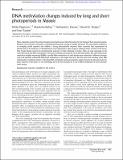Files in this item
DNA methylation changes induced by long and short photoperiods in Nasonia
Item metadata
| dc.contributor.author | Pegoraro, Mirko | |
| dc.contributor.author | Bafna, Akanksha | |
| dc.contributor.author | Davies, Nathaniel J. | |
| dc.contributor.author | Shuker, David M. | |
| dc.contributor.author | Tauber, Eran | |
| dc.date.accessioned | 2016-02-18T11:10:10Z | |
| dc.date.available | 2016-02-18T11:10:10Z | |
| dc.date.issued | 2016-02-01 | |
| dc.identifier | 241082377 | |
| dc.identifier | 5d51108a-f6dc-4998-8201-c1f9c7db9e11 | |
| dc.identifier | 84956964023 | |
| dc.identifier | 000369341900006 | |
| dc.identifier.citation | Pegoraro , M , Bafna , A , Davies , N J , Shuker , D M & Tauber , E 2016 , ' DNA methylation changes induced by long and short photoperiods in Nasonia ' , Genome Research , vol. 26 , no. 2 , pp. 203-210 . https://doi.org/10.1101/gr.196204.115 | en |
| dc.identifier.issn | 1088-9051 | |
| dc.identifier.uri | https://hdl.handle.net/10023/8257 | |
| dc.description | This study was partly supported by a Biotechnology and Biological Sciences Research Council (BBSRC) award to E.T. (BB/K001922/1), N.J.D. (BB/J014532/1), and the University of Leicester Open Scholarship to A.B., and also by the Natural Environment Research Council (NE/J024481/1). | en |
| dc.description.abstract | Many organisms monitor the annual change in day length and use this information for the timing of their seasonal response. However, the molecular mechanisms underlying photoperiodic timing are largely unknown. The wasp Nasonia vitripennis is an emerging model organism that exhibits a strong photoperiodic response: Short autumnal days experienced by females lead to the induction of developmental arrest (diapause) in their progeny, allowing winter survival of the larvae. How female Nasonia control the developmental trajectory of their offspring is unclear. Here, we took advantage of the recent discovery that DNA methylation is pervasive in Nasonia and tested its role in photoperiodism. We used reduced representation bisulfite sequencing (RRBS) to profile DNA methylation in adult female wasps subjected to different photoperiods and identified substantial differential methylation at the single base level. We also show that knocking down DNA methyltransferase 1a (Dnmt1a), Dnmt3, or blocking DNA methylation pharmacologically, largely disrupts the photoperiodic diapause response of the wasps. To our knowledge, this is the first example for a role of DNA methylation in insect photoperiodic timing. | |
| dc.format.extent | 8 | |
| dc.format.extent | 748174 | |
| dc.language.iso | eng | |
| dc.relation.ispartof | Genome Research | en |
| dc.subject | QH426 Genetics | en |
| dc.subject | Genetics | en |
| dc.subject | Genetics(clinical) | en |
| dc.subject | DAS | en |
| dc.subject | BDC | en |
| dc.subject | R2C | en |
| dc.subject.lcc | QH426 | en |
| dc.title | DNA methylation changes induced by long and short photoperiods in Nasonia | en |
| dc.type | Journal article | en |
| dc.contributor.sponsor | NERC | en |
| dc.contributor.institution | University of St Andrews. School of Biology | en |
| dc.contributor.institution | University of St Andrews. Centre for Biological Diversity | en |
| dc.identifier.doi | https://doi.org/10.1101/gr.196204.115 | |
| dc.description.status | Peer reviewed | en |
| dc.identifier.grantnumber | NE/J024481/1 | en |
This item appears in the following Collection(s)
Items in the St Andrews Research Repository are protected by copyright, with all rights reserved, unless otherwise indicated.

